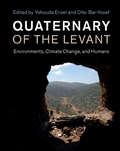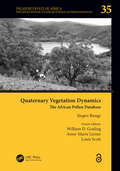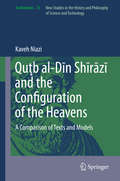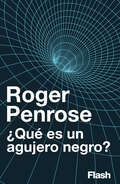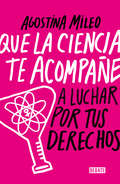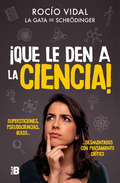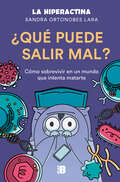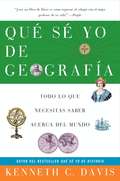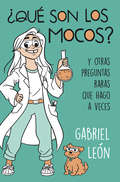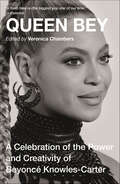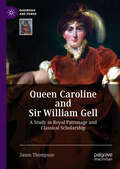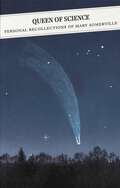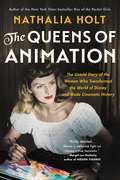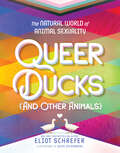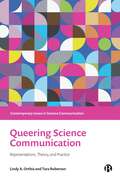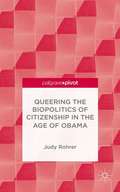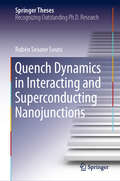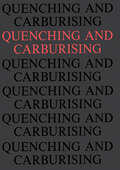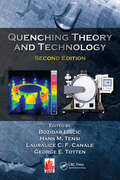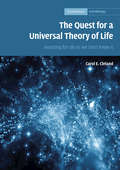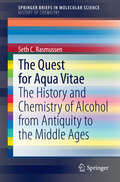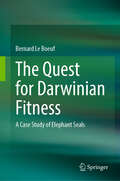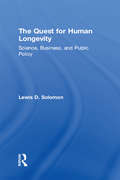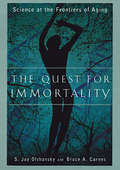- Table View
- List View
Quaternary of the Levant: Environments, Climate Change, and Humans
by Yehouda Enzel Bar-Yosef OferQuaternary of the Levant presents up-to-date research achievements from a region that displays unique interactions between the climate, the environment and human evolution. Focusing on southeast Turkey, Lebanon, Syria, Jordan and Israel, it brings together over eighty contributions from leading researchers to review 2. 5 million years of environmental change and human cultural evolution. Information from prehistoric sites and palaeoanthropological studies contributing to our understanding of 'out of Africa' migrations, Neanderthals, cultures of modern humans, and the origins of agriculture are assessed within the context of glacial-interglacial cycles, marine isotope cycles, plate tectonics, geochronology, geomorphology, palaeoecology and genetics. Complemented by overview summaries that draw together the findings of each chapter, the resulting coverage is wide-ranging and cohesive. The cross-disciplinary nature of the volume makes it an invaluable resource for academics and advanced students of Quaternary science and human prehistory, as well as being an important reference for archaeologists working in the region.
Quaternary Vegetation Dynamics: The African Pollen Database (Palaeoecology of Africa #35)
by Jürgen RungeThis book celebrates the relaunch of the African Pollen Database, presents state-of-the-art of modern and ancient pollen data from sub-Saharan Africa, and promotes Open Access science. Pollen grains are powerful tools for the study of past vegetation dynamics because they preserve well within sedimentary deposits and have a huge diversity in ornamentation that allows different taxa to be determined. The reconstruction of past vegetation from the examination of ancient pollen records thus can be used to characterize the nature of past landscapes (e.g. abundance of forests vs. grasslands), provide insights into changes in biodiversity, and gain empirical evidence of vegetation response to climatic change and human activity. In this, the 35th Volume of "Palaeoecology of Africa", we bring together new data and extensive synthetic reviews to provide novel insights into the relationships between human evolution, human activity, climate change and vegetation dynamics during the Quaternary, the last 2.6 million years. Current and ongoing climate and land-use change is exerting pressure on modern vegetation formations and threatening the livelihoods and wellbeing of many peoples in Africa. In this book the focus is on the Quaternary because it is during this geological period that the modern vegetation formations developed into their current configurations against a backdrop of high magnitude global climate change (glacial-interglacial cycles), human evolution, and a growing human land-use footprint. In this book the latest information is presented and collated from around the African continent to parameterize past vegetation states, identify the drivers of vegetation change, and assess the vegetation resilience to change. To achieve this research from two broad themes are covered: (i) the present is the key to the past (i.e. studies which improve our understanding of modern environments so that we can better interpret evidence from the past), and (ii) the past is the key to the future (i.e. studies which unlock information on how and why vegetation changed in the past so one can better anticipate trajectories of future change). This Open Access book will provide a strong foundation for future research exploring past ecological, environmental and climatic change within Africa and the surrounding islands. The book is organized regionally (covering western, eastern, central, and southern Africa) and it contains specialized articles focused on particular topics (such as modern pollen-vegetation relationships and fire as a driver of vegetation change), as well as regional and pan-African syntheses drawing together decades of research to assess key scientific questions (including the role of climate in driving vegetation change and the role of vegetation change in human evolution). These articles will be useful to students and teachers from high school to the highest level of university who are interested in the origins and dynamics of vegetation in Africa. Furthermore, it is also meant to provide societally relevant information that can act as an inspiration for the development of sustainable management practices for the future.
Quṭb al-Dīn Shīrāzī and the Configuration of the Heavens: A Comparison of Texts and Models
by Kaveh NiaziAs a leading scientist of the 13th century C. E. Quṭb al-Dīn Shīrāzī wrote three substantial works on hay'a (or the configuration of the celestial orbs): Nihāyat al-idrāk fī dirāyat al-aflāk ("The Limits of Attainment in the Understanding of the Heavens"), al-Tuḥfa al-shāhīya fī 'ilm al-hay'a ("The Royal Offering Regarding the Knowledge of the Configuration of the Heavens"), and Ikhtīyārāt-i Muẓaffarī ("The Muẓaffarī Elections"). Completed in less than four years and written in two of the classical languages of the Islamic world, Arabic and Persian, these works provide a fascinating window to the astronomical research carried out in Ilkhanid Persia. Shīrāzī and his colleagues were driven by their desire to rid Ptolemaic astronomy from its perceived shortcomings. An intriguing trail of revisions and emendations in Shīrāzī's hay'a texts serves to highlight both those features of Shīrāzī's astronomy that were inherited from his predecessors, as well as his original contributions to this branch of astronomical research. As a renowned savant, Shīrāzī spent a large portion of his career near centers of political power in Persia and Anatolia. A study of his scientific output and career as a scholar is an opportunity, therefore, for an examination of the patronage of science and of scientific works within the Ilkhanid realms. Not only was this patronage important to the work of scholars such as Shīrāzī but it was critical to the founding and operation of one of the foremost scientific institutions of the medieval Islamic world, the Marāgha observatory. The astronomical tradition in which Shīrāzī carried out his research has many links, as well, to the astronomy of Early Modern Europe, as can be seen in the astronomical models of Copernicus.
¿Qué es un agujero negro?
by Roger PenroseUno de los misterios más fascinante de la física explicado por el flamante Premio Nobel, Sir Roger Penrose. Roger Penrose es probablemente el especialista en la teoría general de la relatividad más prestigioso del mundo y una de las mentes analíticas más originales de la actualidad. En este breve pero magistral texto, Penrose nos embarca en un extraordinario viaje por el espacio y el tiempo que nos permitirá entender las implicaciones de la existencia de uno de los fenómenos más singulares del universo: los agujeros negros. «Cuando Penrose habla, los científicos escuchan.»The New York Times Book Review
¿Qué hay allá arriba? Observar el cielo de noche (¡Arriba la Lectura!, Level L #56)
by Olivia Snow¿Alguna vez has salido a mirar el cielo de noche? Si lees este libro, sabrás qué buscar. NIMAC-sourced textbook
Que la ciencia te acompañe: A luchar por tus derechos
by Agostina MileoDatos científicos de los temas clave en la agenda de género para sostener la crítica feminista. Aunque la humanidad no está formada solo por varones blancos heterosexuales, ellos son el modelo con que el mundo todo se organiza y se piensa. El sexo, la economía, la salud, la tecnología, incluso la ciencia -amparada por una supuesta neutralidad y objetividad-, refuerza estereotipos patriarcales que pasan desapercibidos la mayoría de las veces. Por suerte, Agostina Mileo confronta con sensatez los prejuicios y desarma con lenguaje claro e información accesible, cada uno de los lugares comunes en los que se arraiga el machismo, abriendo la discusión sobre temas como la "utilidad" de los orgasmos, las diferencias entre el cerebro "femenino" o "masculino" (¿y trans?), las falacias sobre el aborto y los mitos de la menstruación. Con irreverencia, demuestra por qué es imperioso construir una mirada crítica y diversa sobre la producción y comunicación del conocimiento, y cuestionar nuestras propias opiniones una y otra vez. En la lucha por una sociedad igualitaria, necesitamos que también ¡la ciencia nos acompañe!
¡Que le den a la ciencia!: Supersticiones, pseudociencias, bulos... desmontados con pensamiento crítico
by Rocío Vidal¡Que le den a la ciencia! -con prólogo de Ramón Nogueras- es el más eficaz antídoto contra los bulos. Un libro de pura y sana divulgación científica. Homeopatía, chamanismo, reiki..., muchas son las terapias alternativas que promocionan algunas personas --entre ellos varios influencers muy populares-- como si fuesen la cura definitiva, y real, de todos los males. Sin embargo, como ha podido demostrar Rocío Vidal en sus videos, ninguna de la información que se transmite sobre éstas tiene estudios serios o científicos de su veracidad. De este modo, esta periodista y divulgadora científica ha comenzado una cruzada para destapar timos, mitos y charlatanerías pseudocientíficas desde su canal de vídeos, La gata de Schrödinger. Y, a la vez, para enseñarnos la importancia que tiene la ciencia en la sociedad.
¿Qué puede salir mal?: Cómo sobrevivir a un mundo que intenta matarte
by La Hiperactina¿Qué puede salir mal? es un libro de divulgación científica fascinante y novedoso que nos enseña el mapa básico de nuestro cuerpo para entender de qué estamos hechos, cómo funcionamos y cómo interactuamos con nuestro entorno. En este mundo tan peligroso, ¿cómo es posible que sigas con vida? Desde que somos una sola célula, nuestro organismo se enfrenta a una serie de obstáculos que no le dan respiro: mutaciones genéticas, sustancias tóxicas que entran sin avisar, ataques constantes de virus y bacterias con muy mala leche y una lotería de todo tipo de enfermedades. Sin embargo, para sobrevivir en este mundo hostil que nos rodea, el cuerpo humano está preparado para contraatacar a estas amenazas sin pensárselo dos veces. La crítica ha dicho:«Si no te enteraste ni papa de tus clases de biología, este libro de la Hiperactina te va a salvar la vida... Y además te la va a explicar. PD: El capítulo sobre las drogas es brutal.»José Luis Crespo, Quantum Fracture
Que Se Yo de Geografia
by Kenneth C. DavisAcompáñanos mientras Kenneth C. Davis, autor del bestseller Qué Sé Yo de Historia, nos lleva en un fascinante, asombroso y divertidísimo tour del planeta Tierra -- una excursión que nos abrirá los ojos y la imaginación a un extenso, salvaje y sorprendente mundo que no conocíamos.
¿Qué son los mocos?: Y otras preguntas raras que hago a veces
by Gabriel LeonSi la curiosidad te mata pero las enciclopedias te aburren, ¡este libro es para ti! Si de hacer preguntas raras se trata... ¡yo tengo el récord! Por suerte mi papá es científico y me las responde todas, todas, todas... Para este episodio, mi selección será: -¿Se tiraban peos los dinosaurios? -¿¡Qué hago para que se me pase el hipo!? -¿Envejezco cuando me baño? -¿Por qué la gente tiene distinto color de piel? -Y por supuesto: ¿¡qué son los mocos!? Entre muchas otras... ¡No cambien de canal!
Queen Bey: A Celebration of the Power and Creativity of Beyoncé Knowles-Carter
by Veronica ChambersFEATURED IN: The New York Times Book Review ("New and Noteworthy") •Essence • Newsweek•People • Bustle • PopSugar • Refinery 29 • HelloGiggles' • PureWow • Newsday• AMNewYorkThe Ultimate Beyoncé Collectible"Beyoncé fans will eat it up." —People"You don't need to be in the Beyhive to appreciate Queen Bey...Voices including culture critic Luvvie Ajayi and actress and producer Lena Waithe give us a fresh take on Beyoncé, who's arguably the biggest pop star of our time." —EssenceBeyoncé. Her name conjures more than music, it has come to be synonymous with beauty, glamour, power, creativity, love, and romance. Her performances are legendary, her album releases events. She is not even forty but she has already rewritten the Beyoncé playbook more than half a dozen times. She is consistently provocative, political and surprising. As a solo artist, she has sold more than 100 million records. She has won 22 Grammys and is the most-nominated woman artist in the history of Grammy awards. Her 2018 performance at Coachella wowed the world. The New York Times wrote: "There's not likely to be a more meaningful, absorbing, forceful and radical performance by an American musician this year or any year soon." Artist, business woman, mother, daughter, sister, wife, black feminist, Queen Bey is endlessly fascinating. Queen Bey features a diverse range of voices, from star academics to outspoken cultural critics to Hollywood and music stars. Essays include:"What Might a Black Girl Be in This World," an introduction by Veronica Chambers"Beychella is Proof That Beyoncé is the Greatest Performer Alive. I’m Not Arguing." by Luvvie Ajayi"On the Journey Together," by Lena Waithe"What Beyoncé Means to Everyone," by Meredith Broussard with visualizations by Andrew Harvard and Juan Carlos Mora"Jay-Z's Apology to Beyoncé Isn't Just Celebrity Gossip — It's a Political Act" by Brittney Cooper"All Her Single Ladies" by Kid Fury "The Elevator" by Ylonda Gault "The Art of Being Beyoncé" by Maria Brito"Getting, Giving and Leaving" by Melissa Harris Perry and Mankaprr Conteh"Beyoncé the Brave" by Reshma Saujani"Living into the Lemonade: Redefining Black Women’s Spirituality in the Age of Beyoncé" by Candice Benbow"Beyoncé’s Radical Ways" by Carmen Perez"Finding la Reina in Queen Bey" by Isabel Gonzalez Whitaker"Beyoncé, Influencer" by Elodie Maillet Storm"The King of Pop and the Queen of Everything" by Michael Eric Dyson"Style So Sacred" by Edward Enninful"The Beauty of Beyoncé" by Fatima Robinson "Because Beyoncé." by Ebro Darden"King Bey" by Treva B. Lindsey"Meridonial: Beyoncé’s Southern Roots and References" by Robin M. Boylorn"B & V: A Love Letter" by Caroline Clarke
Queen Caroline and Sir William Gell: A Study in Royal Patronage and Classical Scholarship (Queenship and Power)
by Jason ThompsonThis book explores the relationship between Queen Caroline, one of the most enigmatic characters in Regency England, and Sir William Gell, the leading classical scholar of his day. Despised and rejected by her husband, Caroline created a sphere and court of her own through patronage of scholarship. The primary beneficiary was Gell, a pioneering scholar of the classical world who opened new dimensions in the study of ancient Troy, mainland Greece, and Ithaca. Despite his achievements, Gell had scarce financial resources. Support from Caroline enabled him to establish himself in Italy and conduct his seminal work about ancient Rome and, especially, Pompeii, until her sensational trial before the House of Lords and premature death. Concluding with the first scholarly transcription of the extraordinary series of letters that Caroline wrote to Gell, this volume illuminates how Caroline sought power through patronage, and how Gell shaped classical scholarship in nineteenth-century Britain.
Queen of Science: Personal Recollections of Mary Somerville (Canongate Classics #102)
by Mary SomervilleThe complete memoirs of the 19th century scientist, public intellectual, and first female member of the Royal Astronomical Society.Born in Jedburgh in 1780, Mary Fairfax was the daughter of a captain in Lord Nelson&’s navy. In common with most girls of her time and station, she received an education that prized gentility over ability. Nevertheless, she taught herself algebra in secret, and made her reputation in celestial mechanics with her 1831 translation of Laplace&’s Mécanique céleste as The Mechanism of the Heavens.A brilliant polymath with interests in art, literature and nature, Somerville&’s memoirs give a fascinating picture of her life and times from childhood in Burntisland to international recognition and retirement in Naples. She recounts memories of comets and eclipses, high society in London and Paris, Charles Babbage and his calculating engine, encounters with Sir Walter Scott and Fenimore Cooper, the Risorgimento in Italy and the eruption of Vesuvius.Selected by her daughter and first published in 1973, these are the memoirs of a remarkable woman who became one of the nineteenth century&’s most accomplished mathematicians and scientists. Oxford&’s Somerville College was named after her, and the present volume, re-edited by Dorothy McMillan, draws on manuscripts owned by the college, offering the first unexpurgated edition of these revelatory writings.
The Queens of Animation: The Untold Story of the Women Who Transformed the World of Disney and Made Cinematic History
by Nathalia HoltFrom the bestselling author of Rise of the Rocket Girls, the untold, "richly detailed" story of the women of Walt Disney Studios, who shaped the iconic films that have enthralled generations (Margot Lee Shetterly, New York Times bestselling author of Hidden Figures) From Snow White to Moana, from Pinocchio to Frozen, the animated films of Walt Disney Studios have moved and entertained millions. But few fans know that behind these groundbreaking features was an incredibly influential group of women who fought for respect in an often ruthless male-dominated industry and who have slipped under the radar for decades. In The Queens of Animation, bestselling author Nathalia Holt tells their dramatic stories for the first time, showing how these women infiltrated the boys' club of Disney's story and animation departments and used early technologies to create the rich artwork and unforgettable narratives that have become part of the American canon. As the influence of Walt Disney Studios grew---and while battling sexism, domestic abuse, and workplace intimidation---these women also fought to transform the way female characters are depicted to young audiences.With gripping storytelling, and based on extensive interviews and exclusive access to archival and personal documents, The Queens of Animation reveals the vital contributions these women made to Disney's Golden Age and their continued impact on animated filmmaking, culminating in the record-shattering Frozen, Disney's first female-directed full-length feature film.
Queer Ducks (and Other Animals): The Natural World of Animal Sexuality
by Eliot SchreferThis groundbreaking illustrated YA nonfiction title from two-time National Book Award finalist and New York Times bestselling author Eliot Schrefer is a well-researched and teen-friendly exploration of the gamut of queer behaviors observed in animals.A quiet revolution has been underway in recent years, with study after study revealing substantial same-sex sexual behavior in animals. Join celebrated author Eliot Schrefer on an exploration of queer behavior in the animal world—from albatrosses to bonobos to clownfish to doodlebugs.In sharp and witty prose—aided by humorous comics from artist Jules Zuckerberg—Schrefer uses science, history, anthropology, and sociology to illustrate the diversity of sexual behavior in the animal world. Interviews with researchers in the field offer additional insights for readers and aspiring scientists.Queer behavior in animals is as diverse and complex—and as natural—as it is in our own species. It doesn’t set us apart from animals—it bonds us even closer to our animal selves.
Queering Science Communication: Representations, Theory, and Practice
by Lindy A. Orthia and Tara RobersonA book on queer themes and science communication is timely, if not well overdue. LGBTIQA+ people have unique contributions to make and issues to meet through science communication. So, bringing ‘queer’ and ‘science communication’ together is an important step for queer protest, liberation, and visibility. This collection examines the place of queer people within science communication and asks what it means for the field to ‘queer’ science communication practice, theory and research agendas. Written by leading names in the field, it offers concrete examples for academics, students and practitioners who strive to foster radical inclusivity and equity in science communication.
Queering the Biopolitics of Citizenship in the Age of Obama
by Judy RohrerWhere dominant citizenship narratives have heretofore focused on either the state or the nation as qualifiers of belonging, this book draws from the interdisciplinary fields of queer theory, critical race theory, feminist political theory, disability studies, and indigenous studies to further an evolving discussion of what it means to be an American citizen in the Obama era. Rohrer demonstrates that this discussion requires an understanding of the machinations of governmentality and biopolitics in the (re)production of the (proper) citizen.
Quench Dynamics in Interacting and Superconducting Nanojunctions (Springer Theses)
by Rubén Seoane SoutoEffects of many-body interactions and superconducting correlations have become central questions in the quantum transport community. While most previous works investigating current fluctuations in nanodevices have been restricted to the stationary regime, Seoane's thesis extends these studies to the time domain. It provides relevant information about the time onset of electronic correlations mediated by interactions and superconductivity. This knowledge is essential for the development of fast electronic devices, as well as novel applications requiring fast manipulations, such as quantum information processing. In addition, the thesis establishes contact with issues of broad current interest such as non-equilibrium quantum phase transitions.
Quenching and Carburising: Proceedings of the 3rd International Seminar of the International Federation for Heat Treatment (Melbourne, 1991)
by Peter D. HodgsonProceedings of the 3rd International Seminar of the International Federation for Heat Treatment held in Melbourne, in 1991 with the special focus on ‘Quenching and Carburising’. Quenching and Carburising are two of the most basic and widely practised steel heat treatment processes. Each allows the base properties and performance of the steel to be significantly enhanced, such that a relatively inexpensive and simple starting material can be used for a wide range of demanding applications. Nevertheless, the technological developments within those two processes are often ignored in favour of ‘high tech’ surface treatments. The aim of Quenching and Carburising was to review the recent advancements that have been made in these fields.
Quenching Theory and Technology
by Božidar Liščić Hans M. Tensi Lauralice C. F. Canale George E. TottenQuenching is one of the most fundamentally complex processes in the heat treatment of metals, and it is something on which mechanical properties and distortion of engineering components depend. With chapters written by the most respected international experts in the field, Quenching Theory and Technology, Second Edition presents the most authoritat
The Quest for a Universal Theory of Life: Searching for Life As We Don't Know It (Cambridge Astrobiology #11)
by Carol E. ClelandIntegrating both scientific and philosophical perspectives, this book provides an informed analysis of the challenges of formulating a universal theory of life. Among the issues discussed are crucial differences between definitions and scientific theories and, in the context of examples from the history of science, how successful general theories develop. The central problem discussed is two-fold: first, our understanding of life is still tacitly wedded to an antiquated Aristotelian framework for biology; and second, there are compelling reasons for considering that familiar Earth life, which descends from a last universal common ancestor, is unrepresentative. What is needed are examples of life as we don't know it. Potential sources are evaluated, including artificial life, extraterrestrial life, and a shadow biosphere right here on Earth, and a novel strategy for searching for unfamiliar life in the absence of a definition or general theory is developed. The book is a valuable resource for graduate students and researchers studying the nature, origins, and extent of life in the universe.
The Quest for Aqua Vitae
by Seth C. RasmussenEthyl alcohol, or ethanol, is one of the most ubiquitous chemical compounds in the history of the chemical sciences. The generation of alcohol via fermentation is also one of the oldest forms of chemical technology, with the production of fermented beverages such as mead, beer and wine predating the smelting of metals. By the 12th century, the ability to isolate alcohol from wine had moved this chemical species from a simple component of alcoholic beverages to both a new medicine and a powerful new solvent. Of course, this also began the long tradition of production of liqueurs and strong spirits for consumption. The use of alcohol as a fuel, however, did not occur until significantly later periods. This volume presents a general overview of the early history and chemistry of alcohol production and isolation, as well as a discussion of its early uses in both the chemical arts and medicine.
The Quest for Darwinian Fitness: A Case Study of Elephant Seals
by Bernard Le BoeufThe mating game plays a central role in promoting individual biological fitness, but many other life-history traits (physical, physiological, and behavioral) also influence fitness. This book is about the optimal method for measuring biological fitness in mammals. This involves measuring lifetime reproductive success of individuals that survive to breeding age while living freely in nature. Constant monitoring of individuals is required, which explains why such studies are difficult to conduct and rare. I use a long-term study of extremely polygynous northern elephant seals (over 62 continuous years) to illustrate the necessary operations, benefits, pitfalls, and difficulties in conducting such studies. The aim of this treatise is to inform and facilitate future investigations of other animals. The Quest for Darwinian Fitness: Case Studies of Elephant Seals is a long-term study of the lifetime reproductive success of individuals, a practical approach to determining biological fitness. This case study is based on an animal that has been studied intensively. The aim of this chronicle is to facilitate the future long-term of other animals.
The Quest for Human Longevity: Science, Business, and Public Policy
by Lewis D. Solomon"Many scientists today are working to retard the aging process in humans so as to increase both life expectancy and the quality of life. Over the past decade impressive results have been achieved in targeting the mechanisms and pathways of aging. In The Quest for Human Longevity, Lewis D. Solomon considers these scientific studies by exploring the principal biomedical anti-aging techniques. The book also considers cutting edge research on mental enhancements and assesses the scientific doubts of skeptics. The Quest for Human Longevity is also about business. Solomon examines eight corporations pursuing various age-related interventions, profiling their scientific founders and top executives, and examining personnel, intellectual property, and financing for each firm. Academic scientists form the link between research and commerce. Solomon notes that the involvement of university scientists and researchers follows one of two models. The first is a traditional model in which scientists leave academia to work for a corporation or remain in academia and obtain business support for their research. The second is a modern model in which scientists use their intellectual property as a catalyst for acquiring equity interests in the firms they organize. Critics have pointed to the dangers of commercialized science, but Solomon's analysis, on balance, finds that the benefits outweigh the costs and that problems of secrecy and conflicts of interest can be addressed. If scientists succeed in unlocking the secrets of aging and developing drugs or therapies that will allow us to live decades longer, the consequences for society will include profound social, political, economic, and ethical questions. Solomon deals with the public policy aspects of significant life extension and looks at the conflict between those who advocate the acceptance of mortality and the partisans of life. The Quest for Human Longevity will be of interest to policymakers, sociologists, scientists, and studen"
The Quest for Immortality: Science at the Frontiers of Aging
by Bruce A. Carnes S. Jay Olshansky"This is by far the best book I've read on the science of aging."--Andrew Weil, M.D. "Life-span Truth Will Set You Free from Age-old Worries," announced the Chicago Tribune upon the first publication of this book. The New England Journal of Medicine confirmed, "For readers interested in aging and longevity, this small book clearly explains the major concepts...extremely enjoyable to read." From NBC Nightly News with Tom Brokaw to Scientific American to the New York Times, S. Jay Olshansky and Bruce A. Carnes have stirred up controversy and brought clarity to an issue often muddled by exaggeration and pseudoscience. Medical science has uncovered a host of answers to the problems of aging, but many of the most exciting discoveries are buried in scientific journals or overshadowed by popular quick-fix treatments. The Quest for Immortality explains the real science of aging and shows which treatments offered by today's multi-billion-dollar anti-aging industries offer real hope, and which are a waste of money and time.
